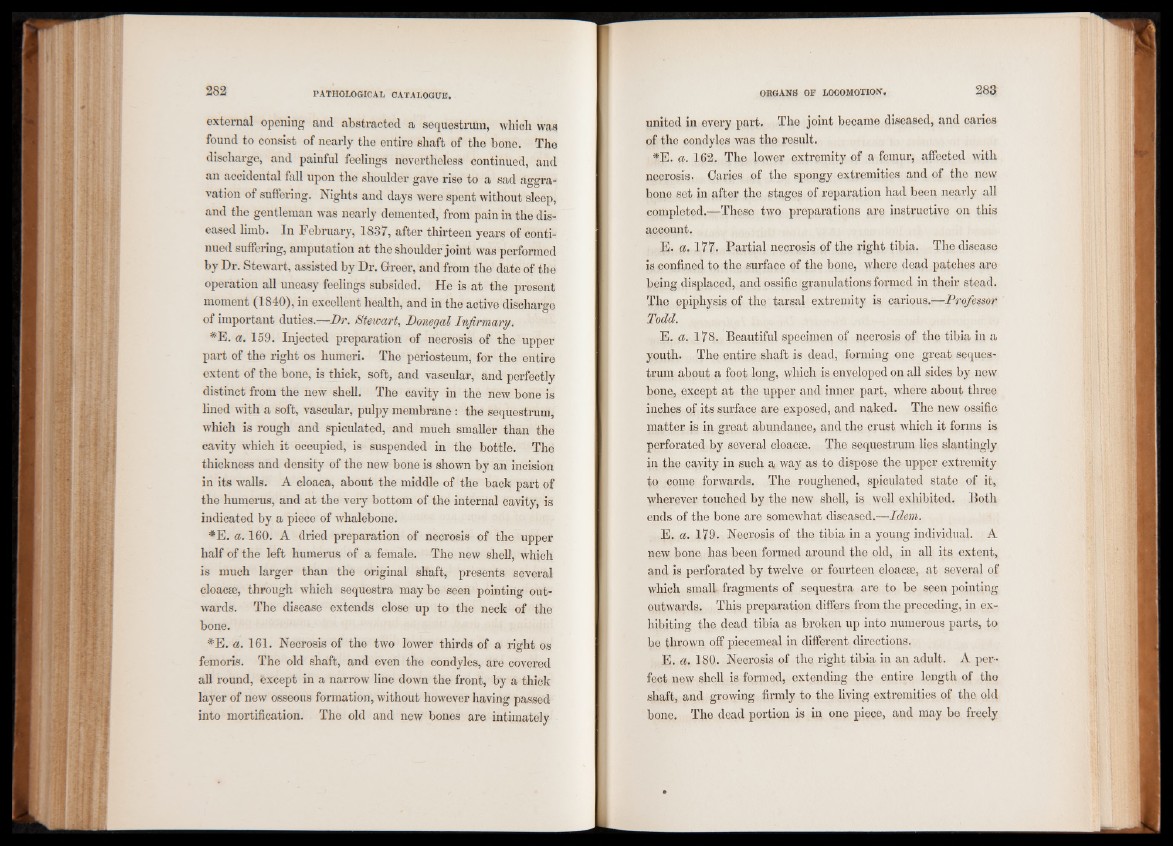
external opening and abstracted a sequestrum, which was
found to consist of nearly the entire shaft of the bone. The
discharge, and painful feelings nevertheless continued, and
an accidental fall upon the shoulder gave rise to a sad assra-
vation of suffering. Nights and days were spent without sleep,
and the gentleman was nearly demented, from pain in the diseased
limb. In February, 1837, after thirteen years of continued
suffering, amputation at the shoulder joint was performed
by Dr. Stewart, assisted by Dr. Greer, and from the date of the
operation all uneasy feelings subsided. He is at the present
moment (1840), in excellent health, and in the active discharge
of important duties.—Dr. Stewart, Donegal Infirmary.
#E. a. 159. Injected preparation of necrosis of the upper
part of the right os humeri. The periosteum, for the entire
extent of the bone, is thick, soft, and vascular, and perfectly
distinct from the new shell. The cavity in the new bone is
lined with a soft, vascular, pulpy membrane : the sequestrum,
which is rough and spiculated, and much smaller than the
cavity which it occupied, is suspended in the bottle. The
thickness and density of the new bone is shown by an incision
in its walls. A cloaca, about the middle of the back part of
the humerus, and at the very bottom of the internal cavity, is
indicated by a piece of whalebone.
*E. a. 160. A dried preparation of necrosis of the upper
half of the left humerus of a female. The new shell, which
is much larger than the original shaft, presents several
cloacae, through which sequestra maybe seen pointing outwards.
The disease extends close up to the neck of the
bone.
#E. a. 161. Necrosis of the two lower thirds of a right os
femoris. The old shaft, and even the condyles, are covered
all round, except in a narrow line down the front, by a thick
layer of new osseous formation, without however having passed
into mortification. The old and new bones are intimately
united in every part. The joint became diseased, and caries
of the condyles was the result.
*E- a. 162. The lower extremity of a femur, affected with
necrosis. Caries of the spongy extremities and of the new
bone set in after the stages of reparation had been nearly all
completed.—These two preparations are instructive on this
account.
E. a. 177. Partial necrosis of the right tibia. The disease
is confined to the surface of the bone, where dead patches are
being displaced, and ossific granulations formed in their stead.
The epiphysis of the tarsal extremity is carious.—Professor
Todd.
E. a. 178. Beautiful specimen of necrosis of the tibia in a
youth. The entire shaft is dead, forming one great sequestrum
about a foot long, which is enveloped on all sides by new
bone, except at the upper and inner part, where about three
inches of its surface are exposed, and naked. The new ossific
matter is in great abundance, and the crust which it forms is
perforated by several cloacae. The sequestrum lies slantingly
in the cavity in such a way as to dispose the upper extremity
to come forwards. The roughened, spiculated state of it,
wherever touched by the new shell, is well exhibited. Both
ends of the bone are somewhat diseased.—Idem.
E. a. 179. Necrosis of the tibia in a young individual. A
new bone has been formed around the old, in all its extent,
and is perforated by twelve or fourteen cloacae, at several of
which small- fragments of sequestra are to be seen pointing
outwards. This preparation differs from the preceding, in exhibiting
the dead tibia as broken up into numerous parts, to
be thrown off piecemeal in different directions.
E. a. 180. Necrosis of the right tibia in an adult. A perfect
new shell is formed, extending the entire length of tho
shaft, and growing firmly to the living extremities of the old
bone. The dead portion is in one piece, and may be freely